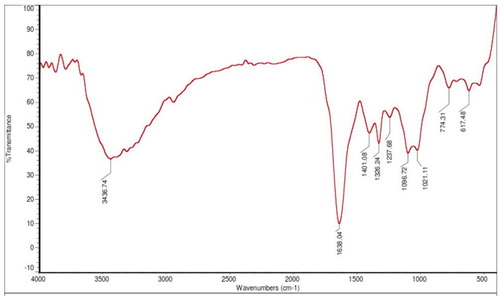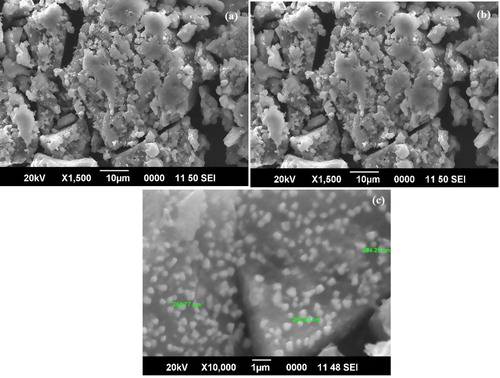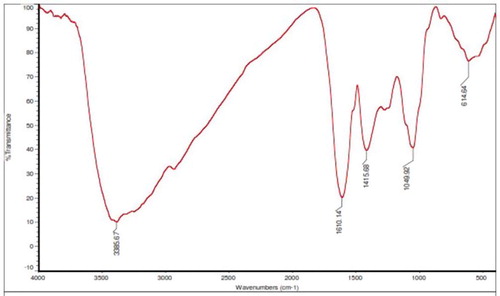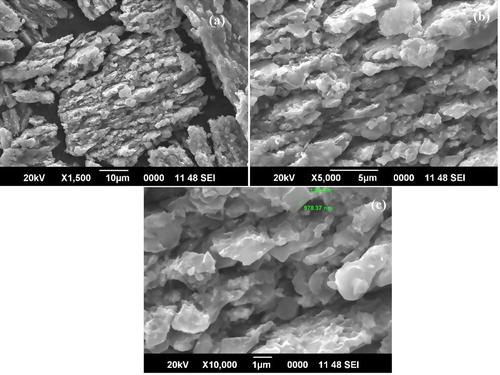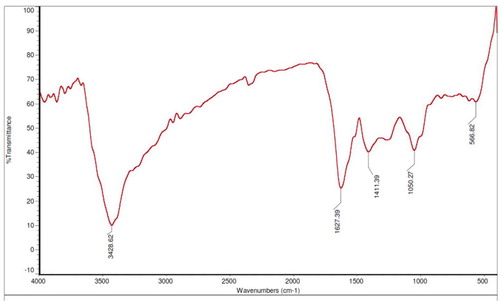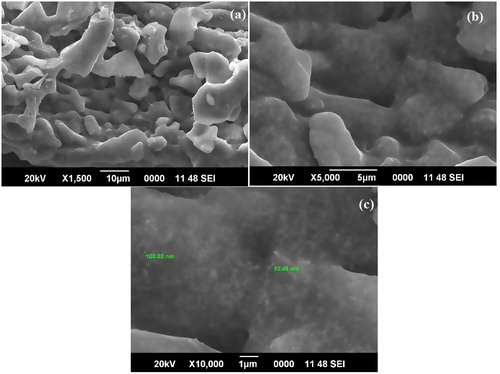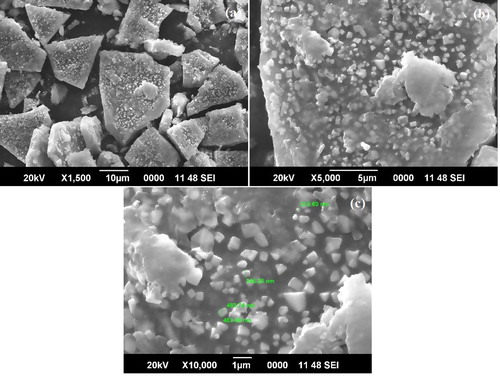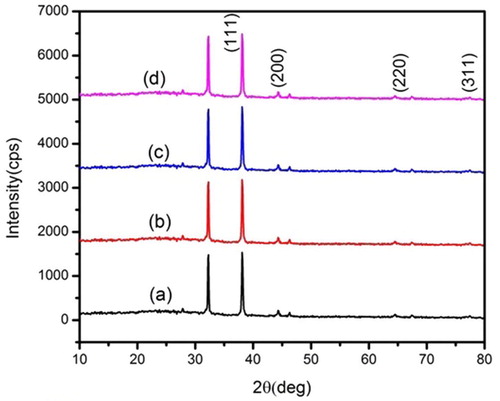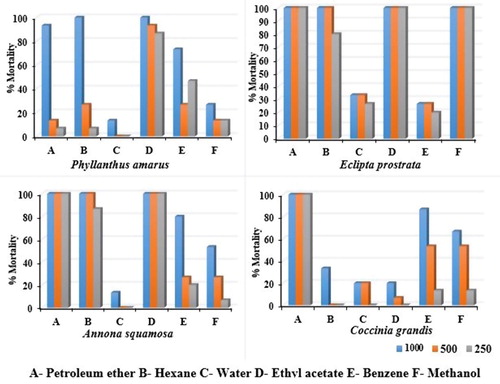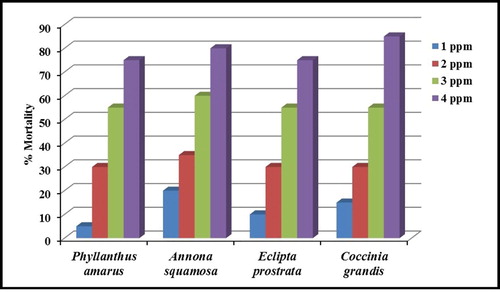Abstract
Larvicidal activity was assessed for alcoholic extracts of Phyllanthus amarus, Annona squamosa, Coccinia grandis and Eclipta prostrata extracted using solvents of various polarity. Third instar stage larvae of Dengue-vector, Aedes aegypti and Japanese encephalitis (JE) causing mosquito Culex tritaeniorhynchus were subjected to larvicidal bioassay at various concentrations (1000, 500, 250 ppm). The results explored that the phytoconstituents and secondary metabolites present in all the plants elucidated potent larvicidal activity. Among the tested extract ethyl acetate, petroleum ether and hexane extract expressed significant larvicidal activity. Similarly, these plants were subjected to green synthesis of silver nanoparticles, characterized and subjected for its larvicidal activity against Anopheles stephensi causing malaria. The synthesized silver nanoparticles were characterized by UV–VIS spectroscopy, Fourier Transform Infra-Red spectroscopy, Scanning Electron Microscopy respectively. The FTIR analysis strongly supported the capping behaviour of bio-reduced synthesized silver nanoparticles which in turn imparted the high stability of the synthesized silver nanoparticles. The average size of synthesized nanoparticles was less than 1 µm, most spherical in shape with SEM analysis. The findings revealed that Eclipta prostrata and Annona squamosa has effective larvicidal activity, whereas all the synthesised nanoparticles demonstrated dose dependent activity even at very low concentration and the findings reveals that these extracts and nanoparticles can be a better remedy against these mosquitoes.
1 Introduction
Mosquito borne diseases is a major universal health problem causing malaria, dengue fever, Japanese encephalitis, chikungunya fever and lymphatic filariasis which are more prevalent in India. It has been reported that 2.5 million cases have been reported with malaria and India alone contributed 76% of the cases [Citation1]. Anopheles stephensi is the malaria causing mosquito of plasmodium genus. About 400 known Anopheles species are normally found everywhere except cold temperate regions. Anopheles stephensi is a major insect vector in the world has been shown directly responsible for about 40–50% of the annual malarial incidence [Citation2]. Similarly, Aedes aegypti a vector of Dengue fever has created a serious public health problem globally. Among the arbovirus in India, spreading all the dengue virus types is constantly increasing [Citation3]. It has been reported that around 50–200 million cases of Dengue fever infection worldwide every year [Citation4]. It is difficult task to control breeding of Aedes aegypti as it is a fresh water breeding mosquito.
Whereas JE (Japanese encephalitis) is caused by mosquito vector Culex tritaeniorhynchus distributed mostly in south Asia and southeast Asia [Citation5] and has reported a mortality of about 30,000–50,000 annually. These vectors breeds especially in irrigation waters of rice field and uses pigs as their amplification host. The symptoms of Japanese Encephalitis infections are mild, with or without apparent symptoms, but many reports suggest that certain patients results in severe disease characterized by raise in body temperature, headache, neck stiffness, disorientation, coma, seizures, spastic paralysis and death. Control of mosquito is something important in the present day with rise in number of illness caused by mosquito and it is a major sources for death in developing countries.
Bioactive compounds from plant origin plays a major role as a defence agent against various insects. A diversity of plants have been reported with insecticidal compounds and the use of products of plants origin to control mosquito larvae has been shown to be an exciting alternative to traditional methods of larval controlling, as they are not associated with the problems [Citation6]. Several research has been carried out to make eco-friendly repellents and larvicidal activity using plants [Citation7,Citation8] . Medicinal plants are found to be the alternative medicine used since ancient times to cure many diseases due to their therapeutic values. Medicinal plants have many characteristics which make them useful for treatments, they are synergic medicine, supportive medicine and preventive medicine [Citation9].
Nanotechnology finds application in different areas like health care, cosmetics, drug-gene delivery, energy science, optoelectronics, photo-catalyst property [Citation10,Citation11] etc. Nanoparticles provides solutions to technological and environmental problems and also provides high surface area to volume ratio. Green synthesis of nanoparticles helps to develop a clean, nontoxic, and eco-friendly methods. They also find place in the insecticides like nanomaterials-based insecticides. They provide green and efficient alternatives for pest management without harming the nature. The atom by atom arrangement of nanoparticle influences their size, shape and orientation to act specifically on the targeted site. The nanoparticle possess more strength, chemical reactivity and a high electrical conductivity, along with their physical, biological and chemical properties.
It has been reported that Silver nanoparticles possess anti-bacterial activity [Citation12] similarly, antiviral [Citation13], anti-fungal activity [Citation14]. Nano particles synthesized from microorganism or plants sources acts can potentially to eliminate the problem by making the nanoparticles more bio-compatible, hence many researchers are working on plants, algae, fungi, bacteria, and viruses to produce low-cost, energy-efficient, and nontoxic production of metallic nanoparticles [Citation15].
The silver nanoparticle efficacy depends on the particle size and their shape. The previous studies shows that reducing agents like borohydride gave smaller monodisperse silver nanoparticles. The use of less reducing agent like citrate gave a slower reducing rate. The chemical synthesis of nanoparticle resulted in toxic and less effective nanoparticles. Green synthesis of nanoparticle is eco-friendly and less toxic. The green synthesis of nanoparticle depends on the selection of substances which are nontoxic, solvents and reducing agent for stability of silver nanoparticles. The experiment is designed to validate the applications of folklore medicine to control the prevalence of diseases.
2 Materials and method
2.1 Collection and processing of plant material
The whole plant samples of Phyllanthus amarus, Annona squamosa, Coccinia grandis and Eclipta prostrata were collected from bottom of Kolli Hills, Namakkal District. These scientific names of these plants were morphologically identified using the database and classified based on their family and authenticated. The fresh leaves were collected, washed and shade dried. The leaves were coarsely powdered by using electric blender and stored separately in an air tight container for further use.
2.2 Chemicals and solvents
All the chemicals and solvents were of analytical grade and obtained from S.D. Fine Chemicals, Mumbai and Fischer Inorganic and Aromatic Limited, Chennai, India.
2.3 Preparation of extract
Dried powdered samples of Phyllanthus amarus, Annona squamosa, Coccinia grandis and Eclipta prostrata were taken separately and mixed with different polar and non-polar and then magnetically stirred in a separate container for overnight at room temperature. The residue was removed by filtration. The filtrate was concentrated under reduced pressure in a rotary evaporator at 60 ± 10 °C to yield concentrated crude extract and the extracts were stored at 4 °C for future use without deterioration [Citation16].
2.4 Synthesis of silver Nano particle
AgNPs were synthesized from the whole plant material (Phyllanthus amarus, Annona squamosa, Coccinia grandis and Eclipta prostrata) by the method explained by Rajakumar and Rahuman, [Citation17].
2.5 Collection of mosquito larvae
The third instar stage larvae of Anopheles stephensi, Aedesaegypti and Culex tritaeniorhynchus were collected from Medical Entomological Centre, ICMR (field station), Virudhachalam, Cuddalore District. The larvae were maintained in aplastic tray containing water with sufficient feed. The tray was covered with muslin cloth to avoid contamination. The larvae were provided with suitable environmental condition of 25–27 °C and 75–85% humidity and the egg rafts were collected from each cage for maintaining next generation.
2.6 Bioassay for larvicidal activity
The assay was carried out according to guidelines of WHO (1996), larvae are added to 249 ml of water and 1.0 ml of prepared plant extracts by maintaining five replicates. The control will be maintained without extract and the replicates are left for exposure for 24 h. Then the number of viable larvae will be reported for assessment of mortality rate from the mean of triplicates. The extracts showing higher activity will be considered for further studies.
Percentage mortality = (No of dead larva/No of larva introduced) × 100
Study involves 5 larvae for each sample. The stock solution (1000 ppm) was prepared by combination of 100 ml of distilled water, 0.4 ml of acetone, 100 mg of extract and 0.02 ml of Tween 20 (for complete dissolution of extract). By diluting further, solutions of concentration 1000, 500, 250 ppm was obtained. Negative control was maintained for all the samples containing only solvent without extract. A commercial liquidator was used as positive control at three concentrations.
2.7 Dose-response bioassay
The synthesized Nano particles were subjected to larvicidal activity against larvae of Anopheles stephensi following the method of Rajakumar and Rahuman, 2011 [Citation18].
3 Results
3.1 Characterization of silver nanoparticles
Synthesis of silver nanoparticles was confirmed by the values and from characterization of the particle using UV, FTIR and SEM analysis.
3.1.1 FTIR and SEM analysis of Phyllanthus amarus
FTIR measurement was carried out to identify the possible biomolecules responsible for capping and efficient stabilization of Ag nanoparticle synthesized by plant leaf extract. FTIR analysis showed the presence of different functional groups corresponding to proteins, alkaloids, tannins, saponins and other plant metabolites. The FT-IR spectrum of AgNPs from P. amarus is shown in . The characteristics absorbance bands due to aldehydic C–H stretch at 2930 cm−1. The band at 1638 cm−1 is due to C–O stretch and the band at 1401 cm−1 is for N–O stretch of amines. The band at 1326 cm−1 is due to the C–O stretch of dialkyl, and 1049 cm−1 is for the C–N. The band at 614 cm−1 is due to aromatic C–H stretch. The broad band which appeared at 3436 cm−1 is the characteristic absorption for O–H–O of water.
The SEM of silver nanoparticles of P. amarus which showed the synthesis of monodisperse spherical Ag NPs (). The SEM image showing silver nanoparticles synthesized using plant extract confirmed the development of silver nanostructures by P. amarus. The shape of Ag NPs was spherical and size was less than 300 nm synthesized from P. amarus.
3.1.2 FTIR and SEM analysis of Eclipta prostrata
The FT-IR spectrum of AgNPs from Eclipta prostrata is shown in . The band at 3385 cm−1 for Hydroxy group, H-bonded OH stretch. The band at 1610 cm−1 was assigned to amide. The peak at 1415 cm−1 which expose symmetric stretching of COO− from an amino group. The peak at 1049 cm−1 is for Phosphate ion and the peak at 617 cm−1 for Alcohol. The IR band proved the presence of amines, alcohols, phenols, and aromatic groups and strongly proposes the presence of certain proteins in Eclipta prostrata that act as reducing/capping agents and may be responsible for the synthesis of AgNPs using leaves of E. Prostrata.
SEM analysis provided further detailed insight into the morphology and size details of the silver nanoparticles. The SEM confirmed the development of silver nanostructures and gave clear image of silver nanoparticles from Eclipta Prostrata (). The image showed the particle size of about 1 µm as well the crystal structure of the nanoparticles.
3.1.3 FTIR and SEM analysis of Annona squamosa
The FT-IR spectrum of AgNPs from Annona squamosa is shown in . The peak at 3428 cm−1 is due to the N–H group of amines. The C=O and C–H group are appeared at 1627 cm−1 of esters and alkenes. The N–H and C–H group is appeared at 1411 cm−1 is for amines and alkanes. The C=O for esters are appeared at 1050 cm−1. The CC group appeared at 566 cm−1 is for alkynes.
The SEM image showing the high intensity of silver nanoparticles synthesized by Annona squamosa extract further confirmed the development of silver nanostructures. The synthesized Ag NPs were monodispersed, spherical in shape with size range between 100 and 200 nm and they are quite well distributed without any agglomeration (). The synthesized nanoparticles were fine stabilized by capping agent (plant phytochemicals) thus they were not in direct contact even within the aggregates as seen in SEM image.
3.1.4 FTIR and SEM analysis of Coccinia grandis
The FT-IR spectrum of AgNPs from Coccinia grandis is shown in . The peaks observed for Ag nanoparticles formed through reduction by C. grandis, at 1090 cm−1 (ether linkages), 1404 cm−1 (=NH) and 1639 cm−1 (amide I) suggest the existence of terpenoids and alkaloids attached on the surface of silver nanoparticles. The analysis of IR spectrum also provided an idea about biomolecules containing different functional groups which are present in the underlying system.
The micrograph showed the particle size of about 200 nm as well the crystal structure of the nanoparticles, with uniformly distributed silver nanoparticles on the surface of the cells is observed. However, it does not indicate that all the nanoparticles are attached to the surface of the cells, since those dispersing in the solution may also deposit onto the surface of the cells. The SEM results () represented that synthesized AgNPs were cubic in shape with 300–1 µm size and found to be well dispersed in aqueous medium of Coccina grandis extract.
3.1.5 X-ray diffraction analysis
The XRD patterns of AgNPs with Phyllanthus amarus, Eclipta prostrata, Annona squamosal, Coccinia grandis are shown in (a-d). The diffraction image shows two peaks appeared with 2θ values and these peaks are corresponding to the (1 1 1) and (2 0 0) planes of face cantered cubic structure of silver which are well matched with the standard card (JCPDS 89–3722). The unexpected peaks could be due to the crystallisation of bioorganic phase that occurs on the surface of the AgNPs.
3.2 Larvicidal bioassay of terrestrial plants against Aedes aegypti
The larval mortality of Phyllanthus amarus, Annona squamosa, Eclipta prostrata and Coccinia grandis against Aedes aegypti are given in . Analysis with Phyllanthus amarus demonstrated a maximum activity of 46.66% and 39.33% of mortality in petroleum ether and benzene extracts at 1000 ppm, whereas hexane extract represented minimum activity of 2.6%. Similarly, Hexane extract of E. prostrata posed maximum 100% activity at 500 ppm and ethyl acetate extract at 1000 ppm represented 93.33%. Its minimum activity was observed in methanol and water extracts of about 6.66%. Meanwhile, petroleum ether and ethyl acetate extracts of Annona squamosa illustrated maximum of 66.66 and 73.33% of mortality respectively. Its water and benzene extracts showed minimal activity of 13.33%. Only the methanolic leaf extract of C. grandis showed 33.33% mortality at 1000 ppm. The plant showed no activity at 250 and 500 ppm concentration of hexane, methanol and benzene extracts.
3.3 Larvicidal bioassay of terrestrial plants against Culex tritaeniorhynchus
The larval mortality of Phyllanthus amarus, Annona squamosa, Eclipta prostrata and Coccinia grandis against Culex tritaeniorhynchus are given in . Analysis demonstrates that Phyllanthus amarus was highly effective with 100% mortality in ethyl acetate and hexane extracts at 1000 ppm concentration, but petroleum ether extract revealed around 93.33% mortality. Its water and methanol extract explicated lowest activity around 6.6 to 13%. E. prostrata showed 100% mortality in petroleum ether, ethyl acetate, hexane and methanol extracts at 250, 500 & 1000 ppm. Its benzene and water extract explicated minimum activity of 26% and 33.3% respectively. Annona squamosa exhibited 100% mortality in petroleum ether, ethyl acetate and hexane extracts. Meanwhile its benzene and methanol extracts were moderately active with mortality rate of 80% and 53% respectively. Coccinia grandis demonstrated 100% mortality in petroleum ether extract and 86.66% mortality in benzene extract. Benzene extract showed moderate activity of 66%. Its water and ethyl acetate extract showed minimum activity of 20% at 1000 ppm concentration.
3.4 Larvicidal bioassay for different concentration of nanoparticle against Anopheles stephensi
Illustration from demonstrates larvicidal activity of synthesized Nanoparticles against Anopheles stephensi. Exposure of Phyllanthus amarus nanoparticles at 4 ppm concentration presented 73% mortality where as 3 ppm demonstrated 53% activity, similarly Annona squamosa based nanoparticle explicated effective activity of 80% mortality at 4 ppm concentration and 60% mortality at 3 ppm. Eclipta prostrata at 4 ppm exposed groups represented 73% mortality and at 3 ppm showed 52% activity. Meanwhile Coccinia grandis NPs at a dose of 4 ppm showed a maximum activity with 83%, and 52% at 3 ppm exposure. All the tested NPs demonstrated potent larvicidal activity even at lower concentration and the results are represented in .
Table 1 Larvicidal activity of synthesized AgNPs against Anopheles stephensi.
4 Discussions
4.1 Characterization of silver nanoparticles
IR spectroscopy study has confirmed that the carbonyl group of amino acid residues and peptides of proteins has a stronger ability to bind metal, so that the proteins could most possibly form a coat covering the metal nanoparticles (i.e. capping of Ag NP) to prevent the agglomeration of the particles, and thus, the nanoparticles are stabilized in the medium [Citation19].
A small dip was obtained at 450–500 nm showing the absorption spectra of Ag NPs synthesized by Phyllanthus amarus. FTIR confirms the presence of different functional groups absorb characteristic frequencies of IR radiations [Citation20].
SEM analysis which constitutes a large number of uniform sized nanoparticles revealed that the Ag nanoparticles produced by reduction of Ag+ ions with leaf extract are predominantly spherical in shape they are quite well distributed without any agglomeration [Citation9]. At low magnification SEM image shows monodispersed NPs with the size ranging from 200 to 300 nm.
The XRD patterns clearly demonstrates that the AgNPs formed in the current synthesis were crystalline in nature. The sharpening of the peaks clearly specifies that the particles are in the nanoregime. Nanoparticle XRD patterns exhibit several different size-dependent features leading to anomalous peak positions, intensity and widths. Appearances of these peaks are due to the presence of phytochemical compounds in the extracts. The stronger planes indicate Ag NPs as a key element in the biosynthesis. The minor shift in the peak positions in all the samples indicated the presence of some strain present in the crystal structure [Citation21].
4.2 Larvicidal activity
It is evident that there is a global alarm is in raise against vector control due to the development of resistance in vector mosquitoes over conventional insecticides. Hence the present study focuses on the development of larvicides using medicinal plants like Phyllanthus amarus, Annona squamosa, Coccinia grandis and Eclipta prostrata and to validate its traditional usage. An attempt is made to green synthesize silver nanoparticles from whole plant and to identify its lethal effect over mosquito larva.
4.2.1 Larvicidal activity of terrestrial plants against Aedes aegypti
Larvicidal activity was evaluated against Aedes aegypti and the results revealed that ethyl acetate and petroleum ether extracts of all the terrestrial plants were effective. The Eclipta prostrata extract exhibited higher mortality when ethyl acetate, petroleum ether and hexane were used as solvents. Annona squamosa demonstrated does dependent activity against Aedes larvae. Only petroleum ether and ethyl acetate extracts of Phyllanthus amarus explicated considerable activity. The least activity on Aedes species was seen in Coccinia grandis. Our study is in line with the previous study representing larvicidal activity using medicinal plants [Citation22]. Also it was found that the extracts demonstrated concentration dependent activity, ie. increase in mortality rate with increase in concentration of extract. The results are in coincidence with the previous reports exploring dose dependent activity supported by the presence of phytochemicals which have insecticidal property [Citation22,Citation23] .
4.2.2 Larvicidal bioassay of terrestrial plants against Culex tritaeniorhynchus
During the trail with Culex larvae the petroleum ether, ethyl acetate extracts of the terrestrial plants were effective. The highest activity was observed in petroleum ether, ethyl acetate, hexane and methanol extracts of E. prostrata. Similarly, Annona squamosa and Phyllanthus amarus ethyl acetate and petroleum ether extracts represented effective mortality against Culex larvae. Previous reports suggest that the biological activity of plant extracts might be due to the presence of various compounds, including phenolics, terpenoids, and alkaloids present in plants [Citation24]. The finding of the present study revealed that these phytoconstituents present in the plant extracts has represented pronounced effect over mosquito larvae. Among the tested plant extract Eclipta prostrata and Annona squamosa demonstrated effective larvicidal activity against Culex larvae and are quite comparable with previous reports of Raheli et al., [Citation25] representing larvicidal activities of leaf extracts of Indigofera arrecta.
4.3 Larvicidal activity of nanoparticle extract of terrestrial plants against Anopheles stephensi
The results of morality rate of Anopheles stephensi at different concentration of nanoparticle extracts were illustrated in . Coccinia grandis AgNPs represented maximum mortality rate against Anopheles stephensi whereas, Annona squamosa AgNPs explicted activity moderate than Phyllanthus amarus and Eclipta prostrata AgNPs. The results demonstrated that maximum mortality even at very low concentration of 4 ppm.
Researchers has reported that synthesized AgNPs may have significant impact on malaria causing vectors and our results are in line with the previous results [Citation17,Citation18,Citation26] similarly, Velayutham et al., [Citation27] reported silver nanoparticles synthesized using bark aqueous extract of F. racemosa represented maximum larvicidal activity against the larvae of disease spreading vectors which is agrement with our study.
5 Conclusion
The results of our present study reveals that the folklore medicines have synergistic effect and can also be used for various ailment without any side effects. Among the tested plants, all plants expressed activity in different solvents may be due to the presence of phytoconstituents in them. Similarly usage of plant based Nano materials represented dose dependent mortality even at a lower concentration and hence it would be an advantage for the development of clean, nontoxic and environmentally acceptable “green approach” to produce metal nanoparticles for betterment of life and can stop spreading of adverse diseases caused by mosquito larvae.
Acknowledgement
Authors are thankful to the Management and Principal of K.S.Rangasamy College of Technology, Tiruchengode for providing infrastructure and facilities to carry out this research work successfully.
References
- A.KumarN.ValechaT.JainA.P.DashBurden of malaria in India: retrospective and prospectiveAm J Trop Med Hyg77620076978
- A.BashirA.JavidEvaluation of larvicidal activity of Hippophae rhammoides L. Leaves extracts on Aedes aegypti and Anopheles stephensi (Diptera: Culicidae). Middle-EastJ Sci Res135201370370910.5829/idosi.mejsr.2013.13.5.2939
- P.V.FulmaliA.WalimbeP.V.MahadevSpread, establishment and prevalence of dengue vector Aedes aegypti (L.) in Konkan region, Maharashtra, IndiaIndian J Med Res1272008589601
- N.E.MurrayM.B.QuamA.Wilder SmithEpidemiology of dengue: past, present and future prospectsClin Epidemiol512013299309
- J.KeiserM.F.MalteseT.E.ErlangerR.BosM.TannerB.H.Singeret al.Effect of irrigated rice agriculture on Japanese encephalitis, including challenges and opportunities integrated vector managementActa Trop95120054057
- H.P.BoraseC.D.PatilR.B.SalunkheC.P.NarkhedeB.K.SalunkeS.V.PatilPhyto-synthesized silver nanoparticles: a potent mosquito biolarvicidal AgentJ Nanomedine Biotherapeutic Discov32013111
- G.MadhumithaG.RajakumarS.Mohana RoopanA.Abdul RahumanK.Mohana PriyaA.Mary Saralet al.Acaricidal, insecticidal, and larvicidal efficacy of fruit peel aqueous extract of Annona squamosa and its compounds against blood-feeding parasitesParasitol Res11120122189219910.1007/s00436-011-2671-2
- S.MohanaRoopanG.ElangoExploitation of Cocos nucifera a non-food toward the biological and nanobiotechnology fieldInd Crops Prod672015130136
- B.A.Rasool HassanMedicinal plants (importance and uses)Pharma Anal Acta3102012e139
- MojganGoudarziMasoudSalavati-NiasariDavoodGhanbariAminAhmadiSynthesis and characterization of Al(OH) nanoparticles and polymeric nanocompositesJ Clust Sci272016253810.1007/s10876-015-0895-5
- MojganGoudarziMehdiMousavi-KamazaniMasoudSalavati NiasariZinc oxide nanoparticles: solvent-free synthesis, characterization and application as heterogeneous nanocatalyst for photodegradation of dye from aqueous phaseJ Mater Sci Mater Electron201710.1007/s10854-017-6560-z
- M.SathishkumarK.SnehaS.W.WonC.W.S.ChoY.S.Kim YunCinnamon zeylanicum bark extract and powder mediated green synthesis of nano-crystalline silver particles and its bactericidal activityColloids Surf. B: Biointerfaces732009332338
- J.V.RogersC.V.ParkinsonY.W.ChoiJ.L.SpeshockS.M.HussainA preliminary assessment of silver nanoparticle inhibition of monkey pox virus plaque formationNanoscale Res Lett342008129133
- A.PanacekM.KolarR.VecerovaR.PrucekJ.SoukupovaV.Krystofet al.Antifungal activity of silver nanoparticles against Candida sppBiomater30200963336340
- K.N.ThakkarS.S.MhatreR.Y.ParikhBiological synthesis of metallic nanoparticlesNanomed Nanotechnol Biol Med62009257262
- K.Syed Zameer AhmedS.SidhraB.Senthil KumarA.Thanga KumarK.GeethaM.Mohamed Rafiet al.Modulatory effect of dianthrone rich alcoholic flower extract of Cassia auriculata L. on experimental diabetesIntegr Med Res62017131140
- G.RajakumarT.GomathiA.A.RahumanM.ThiruvengadmG.MydhiliSeung-HyunKimet al.Biosynthesis and biomedical applications of gold nanoparticles using Eclipta prostrata leaf extractAppl Sci62016222
- G.RajakumarA.A.RahumanLarvicidal activity of synthesized silver nanoparticles using Eclipta prostrata leaf extract against filariasis and malaria vectorsActa Trop1182011196203
- A.RajeswariD.SujathaK.BalasaraswathiManiUthirappanChellanRoseAsit BaranMandalPhytosynthesis of silver nanoparticles using Coccinia grandis leaf extract and its application in the photocatalytic degradationColloids Surfaces B Biointerfaces942012226230
- P.KalainilaV.SubhaR.S.Ernest RavindranR.SahadevanSynthesis and characterization of silver nanoparticles from Erythrina indicaAsian J Pharm and Clin Res720143943
- Khushboo Singh, Manju P, Sangeeta K, Uma C, Jaya Parkash Y. Green silver nanoparticles of Phyllanthus amarus: as an antibacterial agent against multi drug resistant clinical isolates of Pseudomonas aeruginosa. J Nanobiotechnol 2014; 12:40. 10.1186/s12951-014-0040-x
- M.BaranitharanS.DhanasekaranS.Mahesh BabuN.SridharK.KrishnappaLarvicidal activity of Coleus aromaticus Benth (Lamiaceae) leaf extracts against three vector mosquitoesInt J Res Biol Sci4220145559
- G.PedroA.AubreyE.BryleLarvicidal activity of selected plant extract against Dengue vector Aedes aegypti mosquito international researchJ Biol Sci3420142332
- L.RafaelN.TeresinhaJ.C.MoritzI.G.MariaM.D.EduardoS.F.TaniaEvaluation of antimicrobial and antiplatelet aggregation effect of Solidago chilensis eyenInt J Green Pharm320093539
- M.Raheli NeemaM.OjungaF.RameshThe larvicidal activity of Indigofera arrecta leaf extract against culex mosquito larvaeInt J Bioassays401201536663669
- Santhosh Kumar T, Rahuman, AA, Rajakumar G, Marimuthu S, Bagavan A, Jayaseelan C, Zahir AA, et al., Synthesis of silver nanoparticles using Nelumbo nucifera leaf extract and its larvicidal activity against malaria and filariasis vectors. Parasitol Res 2011; 108(3): 693–702. 10.1007/s00436-010-2115-4
- K.VelayuthamA.A.RahumanG.RajakumarS.Mohana RoopanG.ElangoC.Kamarajet al.Larvicidal activity of green synthesized silver nanoparticles using bark aqueous extract of Ficus racemosa against Culex quinquefasciatus and Culex gelidusAsian Pacific J Trop Med6201395101

